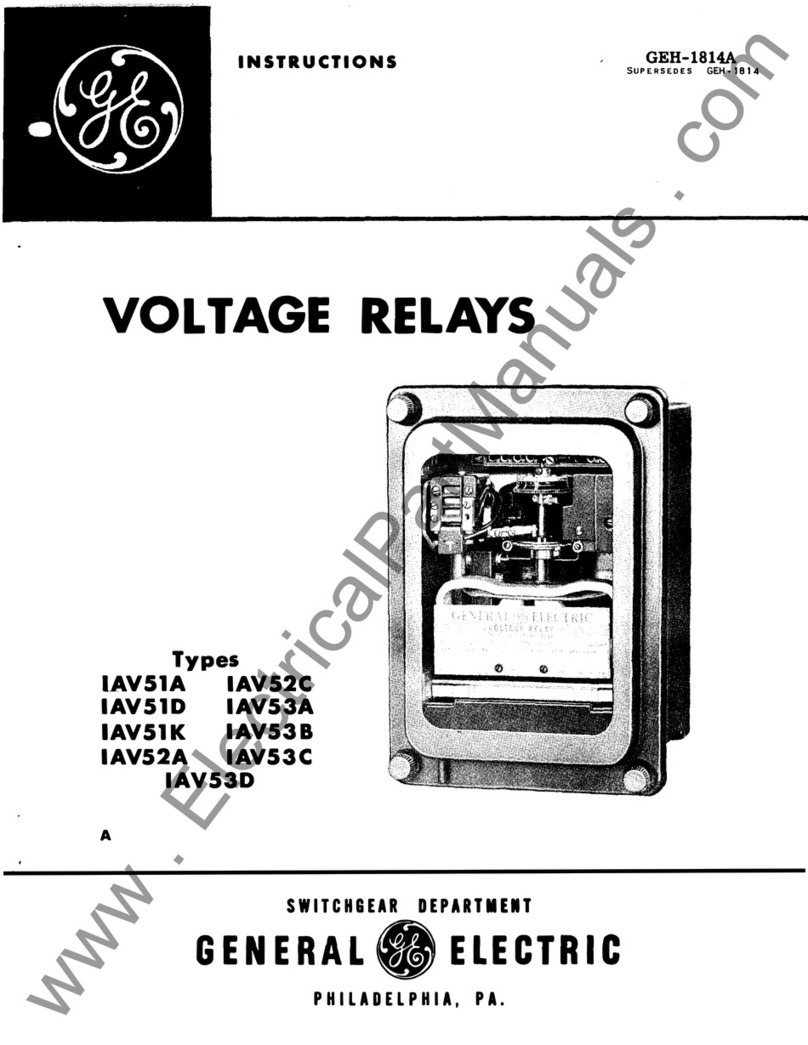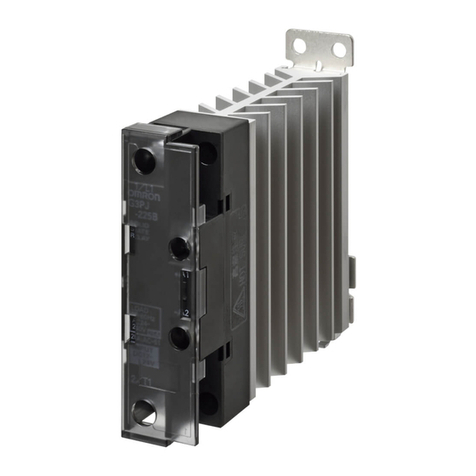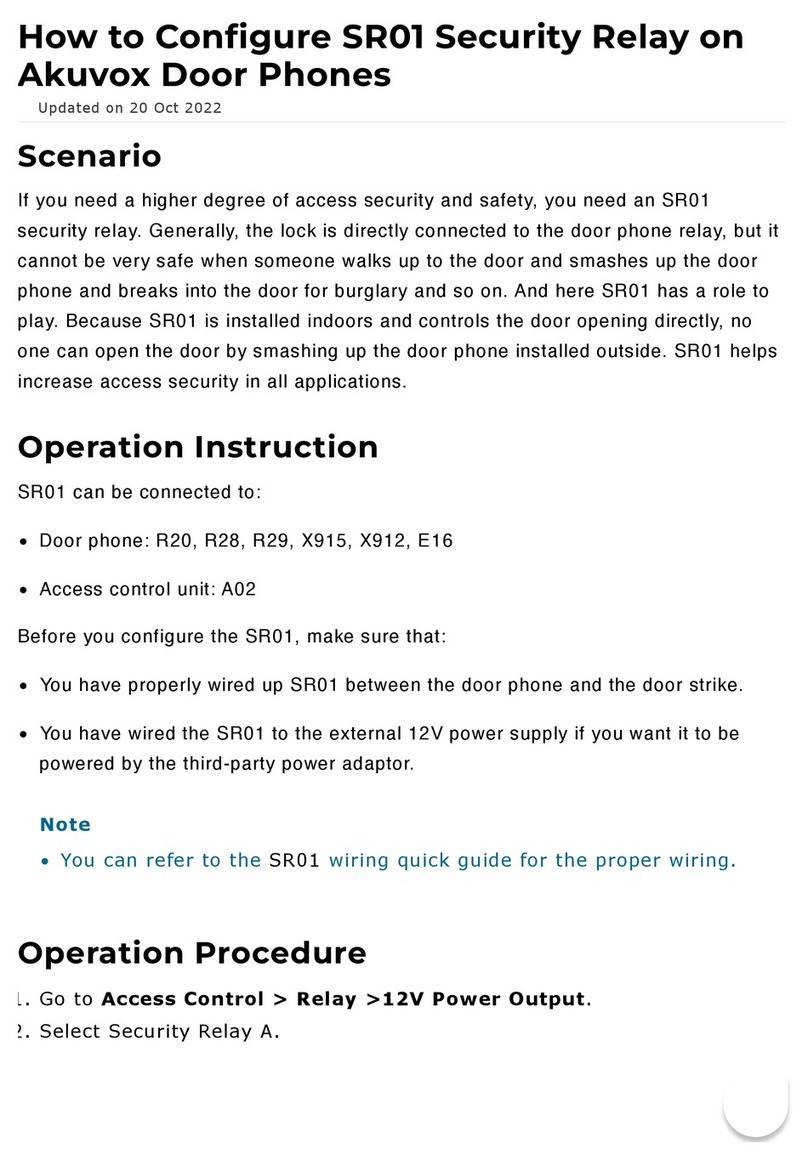BARIX R6 User manual

BARIX R6
DIN-rail mountable relay unit
for commercial control, power
switching and home automation
applications
PRODUCT MANUAL
Version: 01.03
Date: 07/20/2005
For Firmware Version 2
BARIX R6


Table of Contents
Introduc tion.................................................................1
Hard wa re.......................................................................2
Case....................................................................................................2
Connectors......................................................................................2
Power supply requirements......................................................2
RS-485................................................................................................3
LED Indicators................................................................................3
Configuration Memory................................................................3
Conn ect ors ....................................................................4
Connector Pin out overview...................................................4
J5,J6,J7 Pin out (Relays)..............................................................4
J2, J4 Pin out Extension Connectors....................................5
J1 Pin out (RS-485 and Power) ..............................................5
Protocol supp ort ........................................................6
General..............................................................................................6
Supported Standard Commands.............................................6
Special Commands........................................................................6
Exceptions........................................................................................7
Command 68...................................................................................7
Command 69...................................................................................7
Command 70...................................................................................8
Conf igu rati on...............................................................9
Default Parameters......................................................................9

Connecti ng exte rnal loads...................................10
Connecting a Barix Barion et controller........11
RS-485 wiring...............................................................................11
RS-485 troubleshooting...........................................................11
Reference wire............................................................................11
RS-485 termination....................................................................11
Mo dbus Re gister Map.............................................12
Live I/O...........................................................................................12
Configuration Data....................................................................12
Complete Register Map...........................................................14
Complete Coils Map..................................................................14
Tec hni cal s pecifi cat ion s........................................15
CPU..................................................................................................15
Relays...............................................................................................15
Load Connectors........................................................................15
RS-485 / Power Connector....................................................15
Host Interface..............................................................................15
Extension Connectors..............................................................15
Power Supply Requirements..................................................15
LED Indicators.............................................................................15
Case..................................................................................................15
Misc..................................................................................................15
Conformity....................................................................................15

PRODUCT MANUAL - BARIX R6 - V01.03 - 07/20/2005
Introduction
The BARIX R6 is a relay extension unit for the Barionet adding 6
relays capable of switching 10 Amps at up to 250 VAC.
Since the standard Modbus/RTU protocol is used, the BARIX R6
can also be employed in other applications as a Modbus controll-
able relay unit.
The device is configured via the serial interface using standard
Modbus read/writes. If the device ID is unknown, a special
command is available, which can be sent via broadcast and uses
the serial number of the device to send it new configuration info.
A “default settings” jumper allows to set the device temporarily
to a default configuration.
The protocol supported is Modbus/RTU at 19200 (default) and
9600 Baud, with even (default) or no parity.
For applications needing fast setting of relays on multiple devices,
special commands have been added to the standard Modbus
functionality.
Introduction • 1

PRODUCT MANUAL - BARIX R6 - V01.03 - 07/20/2005
Hardware
The BARIX R6 relay extension uses a DIN-Rail mountable plastic
case which directly snaps onto a standard DIN-Rail.
A mounting bracket is also available as an option.
The snap-on cover can easily be removed using a screwdriver.
All screw terminal blocks are conveniently positioned outside of
the cover, so the only reason to remove the cover is to access the
“default” jumper in case the device configuration is not known.
The RS-485 bus and power connection is available on multiple
connectors to facilitate easy daisy-chaining.
8 LED indicators show the status of the outputs as well as power
and RS-485 traffic generated by the unit.
The load connectors are screw terminal connections which allow
the insertion of wires up to AWG14 (2.5mm2). For every relay,
the NO (normally open) and NC (normally closed) contacts are
brought out to a terminal. For safety reasons, these terminal
blocks are not removable. All load connectors are positioned on
the top side of the device.
The RS-485 bus and operating power of the unit can be
connected via a 6-pin removable screw terminal block, positioned
on the bottom side of the device. Two extension connectors
carrying the RS-485 and power connections, one on the left and
one on the right side, facilitate easy daisy chaining of multiple
devices.
The BARIX R6 is equipped with a universal power input and
accepts both AC and DC voltage.The AC supply range is12 to 24
Volts and 9 to 30Volts when powered by a DC power supply. A
switching power regulator generates the internally needed
operating voltage of 5VDC with high efficiency and consumes
with all relays activated maximal 3.5 Watts only.
The R6 is reverse polarity protected.
Hardware •2
Case
Connectors
Power supply
requirements

PRODUCT MANUAL - BARIX R6 - V01.03 - 07/20/2005
The host interface of the BARIX R6 is an RS-485 interface, which
is connectible via extension connectors as well as via screw
terminals. Besides “A” and “B” signals for the differential,
bidirectional bus signal, a third connection is available, commonly
referred to as “reference ground”. This signal is internally tied to
signal ground via a 100 Ohm series resistor.
Termination resistors are NOT provided on-board.
A termination resistor may be added at each far end of the
RS-485 bus, if required.
The BARIX R6, as well as other Barix I/O extension units, feature
soft pull-up (B) and pull down (A) of 10kOhm resistors, which
force the inactive bus to a relatively high impedance, idle
condition. Both A and B line signals are heavily protected against
ESD (Electrostatic Discharge).
Supported interface configurations are
19200 baud, 8bit, even parity, 1 stop bit (**default**)
19200 baud, 8bit, no parity, 1 stop bit
9600 baud, 8bit, even parity, 1 stop bit
9600 baud, 8bit, no parity, 1 stop bit
Eight LED indicators on the unit show the following conditions:
LED 1: operating power
LED 2: R6 answers to Modbus messages
LED 3..8: state of the 6 output relays
The Barionet R6 contains 256 bytes of configuration memory
which can be read and (most of it) written via standard Modbus
commands.The EEPROM based memory is persistent over power
outages, no batteries are used.
Hardware •3
LED Indicators
RS-485
Configuration
Memory

PRODUCT MANUAL - BARIX R6 - V01.03 - 07/20/2005
Connectors
All relays provide separate NO/NC capability, and can switch up
to 10 Amps at max. 250VAC. An indicator LED per relay is
activated together with the relay. The “COM” terminal is
connected to NC if the relay is inactive, and “NO” when the
relay is activated.
Pin J5 J6 J7
1 NC 1 NC 3 NC 5
2 NO 1 NO 3 NO 5
3 COM1COM3COM5
4 NC 2 NC 4 NC 5
5 NO 2 NO 4 NO 5
6 COM 2 COM 4 COM 6
Connectors • 4
Connector Pin out
overview
J5,J6,J7 Pin out
(Relays)

PRODUCT MANUAL - BARIX R6 - V01.03 - 07/20/2005
J2 and J4 (Molex, p/n 22-27-2041, 4A max) are provided for easy
connection of multiple devices, and are located at the left and
right sides. They carry the unregulated supply voltage and RS-485
bus signals.
Pin Function
1 VCC (+)
2 VSS (-)
3RS-485 A
4RS-485 B
J1 can be used to connect the supply voltage and the RS-485 bus
to the relay unit.These screw terminals are electrically identical to
the expansion connectors J2 and J4. In addition, a “reference
ground” and “Signal GND” pin is provided. Reference ground is
connected to the Signal ground of the Barionet R6 via a 100 Ohm
resistor and can be used for grounding applications.“Signal GND”
is the system ground of the R6 – which is NOT identical to the
supply “VSS” pin – and is used for measuring purposes only.
Pin Function
1 Reference GND
2RS-485 A
3RS-485 B
4 VCC (+ or ~)
5 VSS (- or ~)
6Signal GND
Connectors • 5
J1 Pin out (RS-485
and Power)
J2, J4 Pin out
Extension Connectors

PRODUCT MANUAL - BARIX R6 - V01.03 - 07/20/2005
Protocol support
The BARIX R6 communicates via the well known Modbus/RTU
protocol over its RS-485 interface.The unit is also configured via
writes to Modbus registers.
In addition to the actual I/O register(s), a 256 byte information
area is accessible which contains device type, software version,
serial number, the configuration as well as user changeable
storage.
Attention:
Writing to registers can take up to 10 milliseconds per address
before being confirmed (Modbus acknowledge).
The following standard Modbus commands are supported by the
BARIX R6. All other commands will be answered with an
exception code. Due to the limited memory resources of the
BARIX R6, the unit cannot receive messages larger than 95bytes
and will ignore these (for example, write multiple registers
commands).
CMD (hex) Function
03 (0x03) read (holding) register
05 (0x05) write single coil
06 (0x06) write single register
16 (0x10) write multiple registers
The BARIX R6 also supports some special, Barix proprietary
commands which have been implemented to ease configuration
and facilitate the use of the R6 in conjunction with non-Modbus
systems. These commands are further described in this manual
and are:
CMD (hex) Function
68 (0x44) set all outputs on multiple units
69 (0x45) set configuration using serial number
70 (0x66) set coil without acknowledge
Protocol support • 6
General
Supported
Standard
Commands
Special Commands

PRODUCT MANUAL - BARIX R6 - V01.03 - 07/20/2005
The BARIX R6 responds to malformed commands or access
violations with the defined Modbus exceptions.
The command code 68 (hex 44) can be used to set the outputs of
a whole group of R6 devices very fast and efficiently. The
command is sent via broadcast and can address multiple units,
with one byte per device carrying the information for all 6
outputs. All devices addressed by this command will
synchronously set their outputs after the command is completely
received. No acknowledge is returned.
Command format:
Byte 1 - 0xff (broadcast address)
Byte 2 - 0x44 (command code)
Byte 3 - ah (first address, hi, always 0)
Byte 4 - al (first address, Modbus address of first device)
Byte 5 - ch (count, # bytes, hi, always 0)
Byte 6 - cl (count, #bytes, lo 8 bit)
Byte 7 - nb (number of bytes following (redundant)
Byte 8...8+nb: data bytes for multiple devices
Byte 8+nb+1: crc1 (crc1 according to Modbus spec)
Byte 8+nb+2: crc1 (crc1 according to Modbus spec)
Example: a command with al=5, cl=nb=4, data 01,02,04,08
will set the outputs on the R6 with Modbus address 5 to 01
which means relay one on, all others off, outputs on the R6 with
the Modbus address 6 to 02 which means relay two on, all others
off, devices with address 7 and 8 accordingly.
All other devices with Modbus addresses 1..4 and 9..255 are not
affected by the command.
The command code 69 (hex 45) is used to set an R6 device which
is connected to the bus and which address is unknown (but serial
parameters are correct) or which is forced to default settings
with the default jumper.
The command can also be sent multiple times with different serial
parameters to find the device.
Protocol support • 7
Exceptions
Command 69
Command 68

PRODUCT MANUAL - BARIX R6 - V01.03 - 07/20/2005
The serial number of the device, which can be found on a label on
the unit (format xxx-yyy), needs to be inserted into this block to
address the specific unit. The block is sent out as a Modbus
“broadcast”.
Bytes 272, 273, 274, 275 of the Modbus register map
(configuration memory positions 16..19) will be written with the
provided information if the serial number matches.
Command format:
Byte 1 - 0xff (broadcast address)
Byte 2 - 0x45 (command code)
Byte 3 - s1 (serial number, first part)
Byte 4 - s2 (serial number, second part)
Byte 5 - s1 (serial number, first part, repeated)
Byte 6 - s2 (serial number, second part, repeated)
Byte 7 - c1 (configuration data for register 272)
Byte 8 - c2 (configuration data for register 273)
Byte 9 - c3 (configuration data for register 274)
Byte 10 - c4 (configuration data for register 275)
Byte 11 - crc1 (crc1 according to Modbus spec)
Byte 12 - crc2 (crc2 according to Modbus spec)
Despite the broadcast addressing, the unit will respond with a
command acknowledgment (containing bytes 1..6 plus crc) !
The command code 70 (hex 46) is used to set an R6 output
without a return acknowledgment. The command uses the exact
syntax of the 05 (set coil) command, but the R6 does not send an
answer and is immediately ready to receive the next message.
The command should be send addressed to the device address
and NOT as a broadcast, otherwise all R6 units on the bus will
react to it.
This command has been added to the Barionet R6 to allow slow
systems, which are not Modbus native and cannot react fast to
serial input (like common home automation systems) to set a
series of relays of one or multiple R6 units without the need to
observe Modbus message timeouts, answers etc.
Protocol support • 8
Command 70

PRODUCT MANUAL - BARIX R6 - V01.03 - 07/20/2005
Configuration
The BARIX R6 is configured via the RS-485 interface using
standard Modbus commands.
If the address of the device is not known, it can be temporarily set
to default parameters by setting a jumper in the device. No reset
is necessary.Within 5 seconds after applying the jumper, the
default parameters are assumed. It is NOT necessary to reset or
to power cycle the device after removing the jumper ! If no valid
Modbus blocks are received by the relay unit for a 5 second time
interval, the serial interface is reset and reconfigured with stored
parameters.
Use a screw driver to remove the snap-on case top. On one side
of the case lift one latch first and gently pull the top then lift the
second latch and remove the top completely.
J3 is a 4 pin connector and is located between LED7 and LED8.
To set default parameters connect the lower two pins using a
standard jumper (not included).
When the jumper is set, the default parameters are:
Serial interface 19200 Baud, even parity, 1 stop bit
Modbus Address 255
Configuration • 9
Default Parameters

PRODUCT MANUAL - BARIX R6 - V01.03 - 07/20/2005
Connecting external loads
The BARIX R6 features 6 relays capable of switching resistive
loads (lamps, heater) 10 Amps at up to 250 VAC.
~ P
~ N
Cautious calculations should be performed when switching
inductive loads like motors or transformers as used in low voltage
halogen light systems:
A transformer produces a high voltage when switched off causing
an arc which is reducing the life span of the relay contacts.
~ P
12VAC
~ N
Motors have a high start up current (typical factor of 2 to 5
times the nominal current ! ) so even a motor with a nominal
current draw of 5 Amps could reduce the life time of relay
contacts significantly. We advise to check the technical specs of
the used motor and to also take in account the added initial
current draw caused by the attached mechanics.
~ P
M
~ N
Connecting external loads • 10

PRODUCT MANUAL - BARIX R6 - V01.03 - 07/20/2005
Connecting a Barix Barionet controller
The actual Barix Barionet controller features two 3pin expansion
connectors which are NOT compatible with the 4pin expansion
connectors of the BARIX R6. This will be changed in a future
hardware revision of the Barix Barionet controller to allow for
daisy chaining. This is already supported between BARIX R6
devices and other Barionet extension devices.
However, connecting a Barix Barionet controller is simple as it
features the RS-485 signals on J7 which is a detachable screw
terminal block:
Pin 485
1 Reference GND
2Notused
3Notused
4 RS-485 A
5RS-485 B
6 Reference GND
•connect Pin 4 (J7) to Pin 2 (J1) of the BARIX R6 (RS-485 A)
•connect Pin 5 (J7) to Pin 3 (J1) of the BARIX R6 (RS-485 B)
When communication problems occur two measures can be
taken to improve the RS-485 signal quality.
When using two separate power supplies a third wire should be
used to ensure a common voltage level :
•Connect Pin 1 or Pin 6 (J7) to Pin 1 (J1) of the BARIX R6
When the two devices need to be connected over a long distance
both sides of the cable should be terminated using a 100 Ohm
resistor to suppress signal reflections:
•Connect a 100 Ohm resistor between Pin 4 and Pin 5 (J7)
directly at the terminals of the Barionet controller
•Connect a 100 Ohm resistor between Pin 2 and Pin 3 (J1)
directly at the terminals of the BARIX R6
Connecting a Barix Barionet controller • 11
RS-485 wiring
Reference wire
RS-485 termination
RS-485
troubleshooting

PRODUCT MANUAL - BARIX R6 - V01.03 - 07/20/2005
Modbus Register Map
The BARIX R6 supports all 64k address locations in the Modbus
address maps, however, unimplemented locations generate an
exception when read or written.
The Modbus address range is divided in multiple address maps, all
65535 registers in size. The Barionet R6 implements the “coils”
(64k, 1bit) and the “registers” (64k, 16 bit). There are no
functions provided to read back discrete (1bit values) in the
shipping software version.
Attention: all Modbus addresses count from 1, while the
protocol addresses start at 0. Example: Modbus register 1 is
addressed in Modbus/RTU as “0”. This documentation uses
the Modbus register number – in the protocol the address
must be one less !!
The state of the relays can be set/reset using “set coil” and “write
register” commands. In addition, the state of the relays can be
read back using the “read register” command.
In the “coil/discrete” address map, only positions 1..6
(Modbus/RTU addresses 0..5) are populated in the BARIX R6,
which are mapped to relays 1..6. Write access to any other
address is prohibited.
In the “register” address map, the relays can be written
simultaneously by accessing register 1. Bit 0 is relay 1, bit 1 is
relay 2, ... bit 5 is relay 6.
All configurable parameters are accessible using standard Modbus
read/write commands to registers.
The configuration information area is 256 bytes, which are
accessible as 256 byte registers (lower 8 bits only), registers
257..512 in the Modbus memory map.
The first 16 bytes of the configuration registers are “one-time”
writable only – after setting these registers to a value not equal to
255 (hex 0xff) they cannot be changed any more. All other
Modbus Register Map • 12
Configuration
Data
Live I/O

PRODUCT MANUAL - BARIX R6 - V01.03 - 07/20/2005
registers can be read and written. Within these first 16 bytes,
Device type, software version, and serial number are stored. In
addition, the installer of the unit can use 8 bytes to write
permanent information (like shipping date, system ID where the
unit is installed etc). Of the remaining 240 bytes, the first 16 bytes
have a special meaning (configuration registers) – all other
registers (290..512) can be used by the installer/customer to
store information.
Device information such as device ID, software version etc can be
accessed using standard register read commands. This
information is read-only and cannot be overwritten. The
information is accessible using standard reads from addresses
257..264.
Register 257: set fixed to “0xB1” (stands for Barionet R6)
Register 258: software version, 2 at the time of printing.
Register 259: first part of the serial number (byte)
Register 260: second part of the serial number (byte)
Register 261..264 are reserved for future use by Barix
Register 265..272 are usable as one-time writable storage by the
installer or controlling software.
Device configuration can be set and read using standard Modbus
commands. The R6 will reset its actual communications
parameters to these values anytime it does not receive valid host
communication for more than 5 seconds and the default jumper
is NOT set.
Register 273: Default relay settings in this Register are 00 by
default, if Bit 0 is set, Relay 1 will be activated at startup etc..
Register 274: Serial interface mode: only bit 7 and bit 0 are used.
Bit 0 selects between 9600 (set) and 19200 (reset) baud. Bit 7
selects between no (set) and even (reset) parity.
Register 275: This register holds the Modbus address of the unit.
Register 276..289: Reserved for future enhancements.
Modbus Register Map • 13
ID registers
Configuration
registers

PRODUCT MANUAL - BARIX R6 - V01.03 - 07/20/2005
Detailed “register” map – again – please note that the protocol
address in Modbus/RTU is the register number -1 !!
Register Function
1 Live I/O (Byte, Relay state in bit 0..5)
2..256 Reserved, not accessible
257 Device type (hex 0xB1)
258 Firmware version
259 Serial number 1st part
260 Serial number 2nd part
261..264 reserved
265..272 One-time writable for installer
273 Default relay setting for startup
274 Serial interface mode
275 Modbus address
276..289 reserved
290..512 Memory for installer/software use
513....
65536
not accessible
Detailed “coils” map – please note that in the protocol, address in
Mobus/RTU is the coil number -1 !!
Coil Function
1..6 Relay 1..6
7..65536 Reserved, do not access
Modbus Register Map • 14
Complete
Register Map
Complete Coils
Map

PRODUCT MANUAL - BARIX R6 - V01.03 - 07/20/2005
Te c h n i c a l s p e c i f i c a t i o n s
PIC 16F688, 20MHz clock frequency
6 independent relays (250VAC 10A, 16Amax <1sec)
Operate time: 7ms nominal, release time: 3ms nominal.
Contact resistance: 50mOhm (measured at 1A 6V)
Operating cycles: 10mio typical at no load.
Relay type: Massuse ME-11 or equivalent
3 screw terminal blocks non-removable, with common,
NO (normally open) and NC (normally closed) contacts
for wires AWG26 - AWG14 / 0.15 – 2.5mm2
Detachable screw terminal block
for wires AWG28 - AWG16 / 0.08 - 1.3 mm2
RS-485: 9600 and 19200 Baud, 8 bit, even or no parity.
2 extension connectors (4 pin) with RS-485 and power terminals,
Molex 22-27-2041, 4A max., extension cable (3”/75mm) included
(consisting of 2 Crimp Terminal Housings Molex 22-01-2045 and
8 female Crimp Terminals Molex 08-50-0114 of Molex 2759 series)
12 to 24 VAC / 9 to 30 VDC
3.5 Watt max. (all relays active)
1 LED for power indication
1 LED for active traffic indication
6 LEDs for relay status indication
High quality plastic, 220 grams, DIN-rail mountable
"""4.13 x 3.34 x 2.83 /105mm x 85mm x 32mm
Internal connector for default settings jumper
Temperature:32 to 104° F / 0 to 40° C
Humidity: < 70% relative humidity non-condensing
FCC A and B, CE A and B
Emission EN60730-1:2000 (Class B)
Immunity EN60730-1.2000
Technical specifications • 15
CPU
RS-485 / Power
Connector
Power Supply
Requirements
LED Indicators
Case
Misc.
Environmental
conditions
Relays
Extension
Connectors
Load Connectors
Host Interface
Conformity

©2005 Barix AG, Zürich, Switzerland.
All rights reserved.
The newest information about our devices and the latest version of
this manual is available via download from our website,
www.barix.com.
We explicitly reserve the right to change and improve the product
without notice.
All trademarks mentioned or used are belonging to their respective
owners.
Barix, BARIX R6 and Barionet are trademarks of Barix AG,
Switzerland and are registered in certain countries.
Barix AG Barix Technology Inc.
Seefeldstrasse 303 2182 Helena Rd.
8008 Zürich St. Paul, MN 55128
SWITZERLAND USA
Phone: +41 43 433 2211 Phone: (866) 815-0866
Fax: +41 44 274 2849 Fax: (209) 755-8435
Internet
web: www.barix.com
email: [email protected]m
Table of contents
Popular Relay manuals by other brands

Delixi
Delixi XJ3 user manual
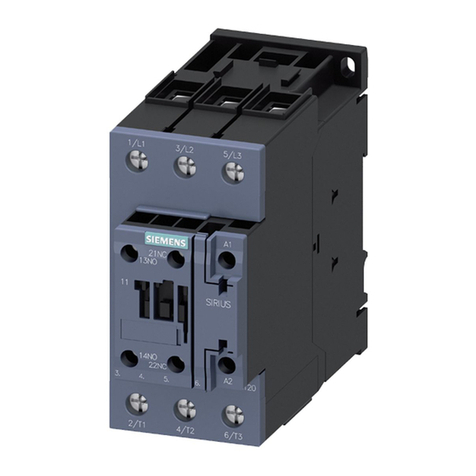
Siemens
Siemens SIRIUS 3RT2.1 Series operating instructions

ASO Safety Solutions
ASO Safety Solutions ISK 74 operating manual
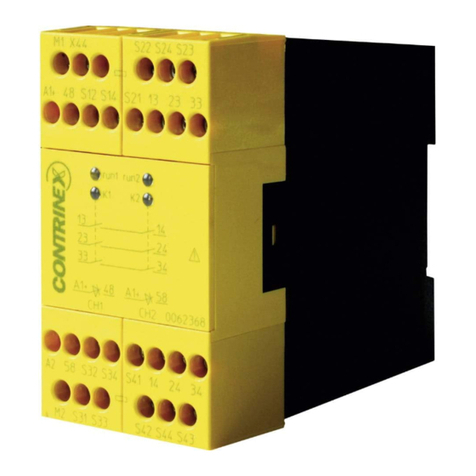
Contrinex
Contrinex YRB-0330-242 operating instructions

Datalogic
Datalogic CS ME-03VU24-Y14 quick start guide
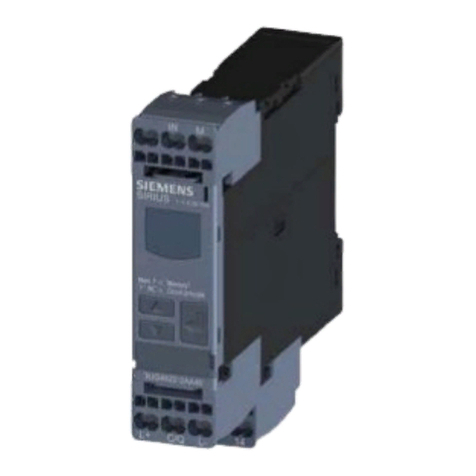
Siemens
Siemens SIRIUS 3UG4822 operating instructions
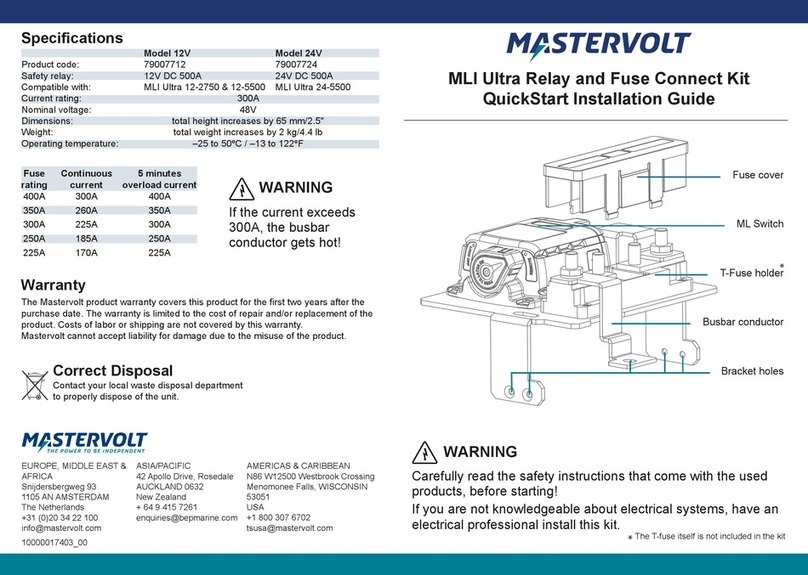
Mastervolt
Mastervolt MLI Ultra Series Quick start installation guide
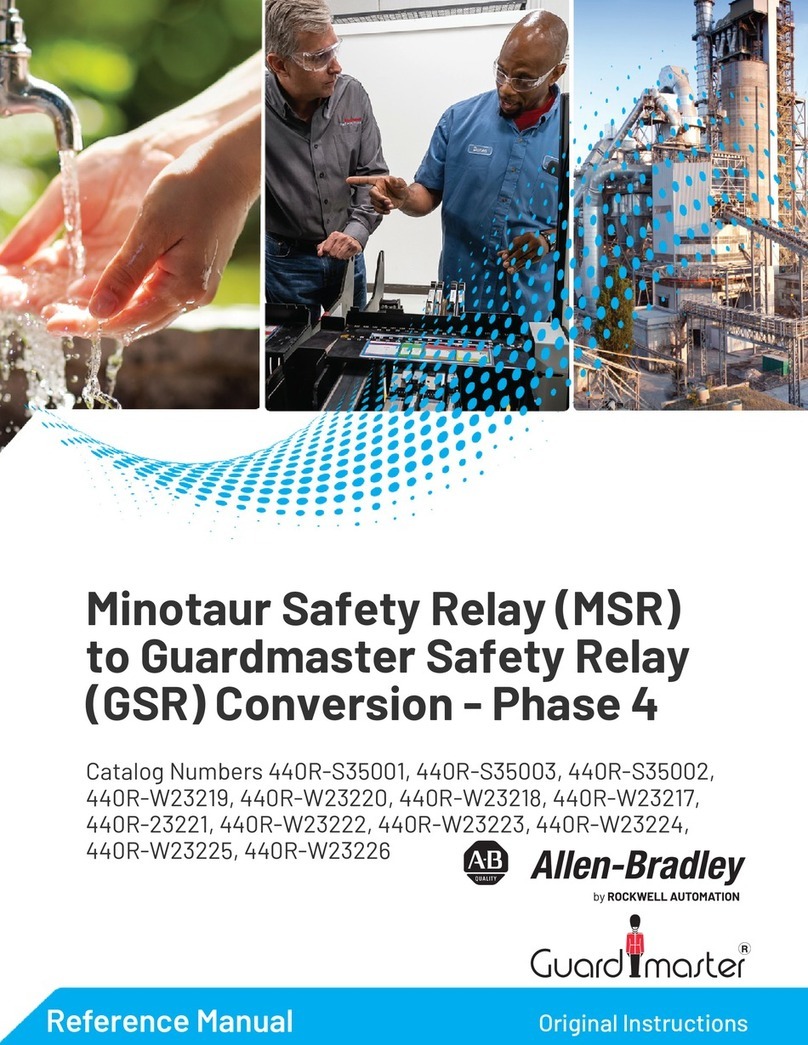
Rockwell Automation
Rockwell Automation Guardmaster Allen-Bradley 440R-S35001 Reference manual
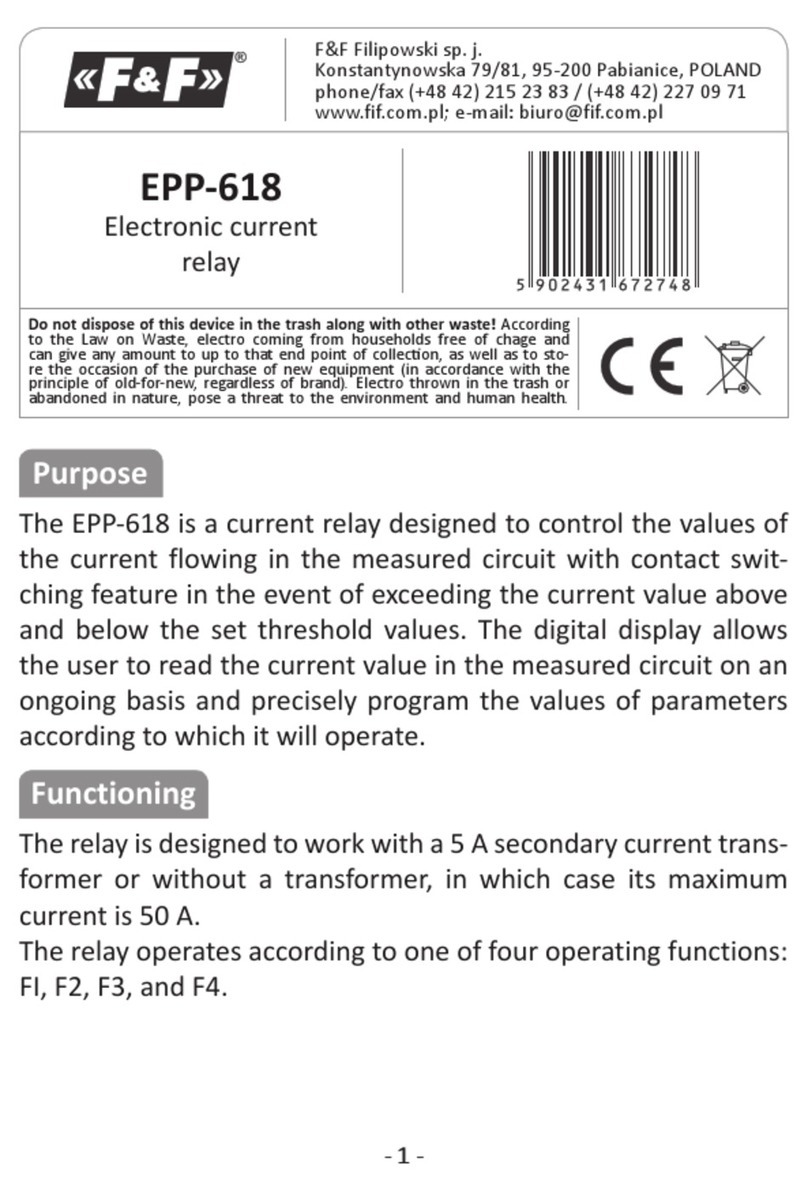
F&F
F&F EPP-618 manual
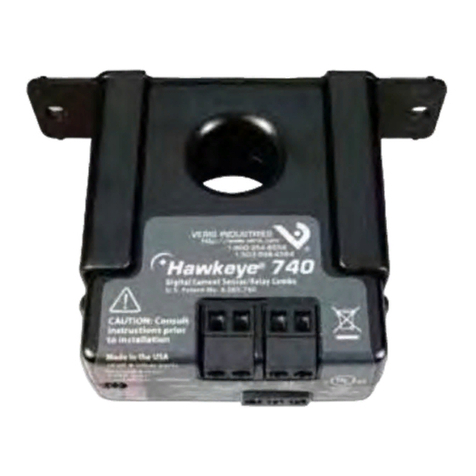
Veris Industries
Veris Industries Hawkeye 740 installation guide
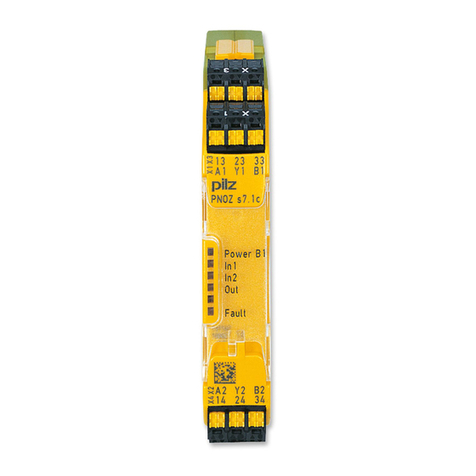
Pilz
Pilz PNOZ s7 operating manual
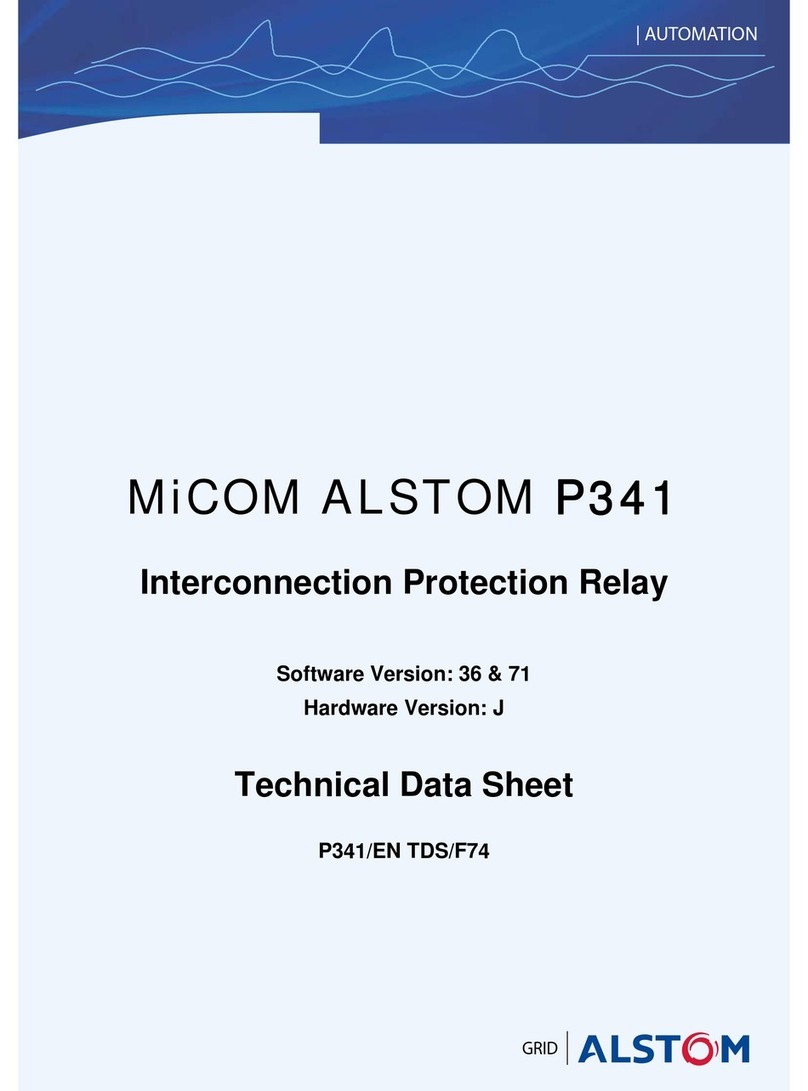
Micom
Micom ALSTOM P341 Technical data sheet

